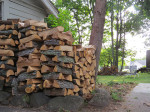IN MAY Gail and I like to go to the eastern Upper Peninsula to watch birds. We do a sort of Grand Tour, from Mackinac State Park to the Seney Wildlife Refuge to Whitefish Point. Whitefish Point is a funnel for migrants, and on some days you can see hundreds of raptors soaring in “kettles” as they wait for a south wind to carry them across the lake to Canada. Sometimes a dozen kettles will be in the sky at once, each speckled with a hundred or more slowly wheeling broad-wings, sharpshins, kestrels, and others. In ponds and wetlands are ducks and geese, and occasionally yellowlegs, bitterns, rails, and other shy water birds. And the trees can be dripping with warblers.
We’re solid intermediate birders but we’ll probably never be experts because of our attention-span problem. We can’t pass a river without wanting to canoe it or fish it. We can’t drive through an aspen woods without stopping to search for morels. If we’re in the mood for chaos and artifice, the casinos draw us in. And every rocky beach beckons with the promise of agates.
One of our favorite agate beaches is at the end of a long, fairly treacherous trail that appears on no maps. Last year when we were there Superior was in a rare mood: calm and steel-gray to the horizon, with small waves lapping the shore. We had found a few small agates in the gravel when, from a thicket of osiers at the top the beach, came a distinctive call—“Wickity wickity wickity.” We were baffled for a moment, then it came to us: the common yellowthroat, a warbler I’ve always thought was not in the least common.
Farther down the shore we discovered half a dozen logs stranded on the beach. They were large—sixteen feet long and two feet in diameter—and worn smooth and bleached nearly white by water and weather. The ends of the logs were stamped with marks to identify the companies that owned them. Most of them were imprinted with the letters “OK.” The others were simple heart shapes.
I remembered meeting a man once on the north shore of Superior who had worked as the skipper of a tugboat that hauled similar logs across Superior. He said the logs were gathered into booms the size of football fields, and his job was to push them across the lake to the sawmills in Sault Ste Marie. He told a story about getting caught in a storm that shoved his tug backward across the lake until the boom broke up against the Michigan shore. Stray logs sometimes drift in the lake for years, he said. Eventually they sink or wash up on beaches.
It was impossible to tell if the logs Gail and I found on the beach that day had been floating in the lake for a year or a decade. Maybe they had been lost from one of those massive booms. I imagined the storm that could shove a tugboat backwards against its thrust and bust chains and scatter logs across a hundred miles of water. If you’ve seen a Lake Superior storm you’ll have no doubt who wins such a contest. Tugs are powerful machines, but the smart money is on Superior.
(Originally published in Michigan Blue Magazine.)


6 Replies